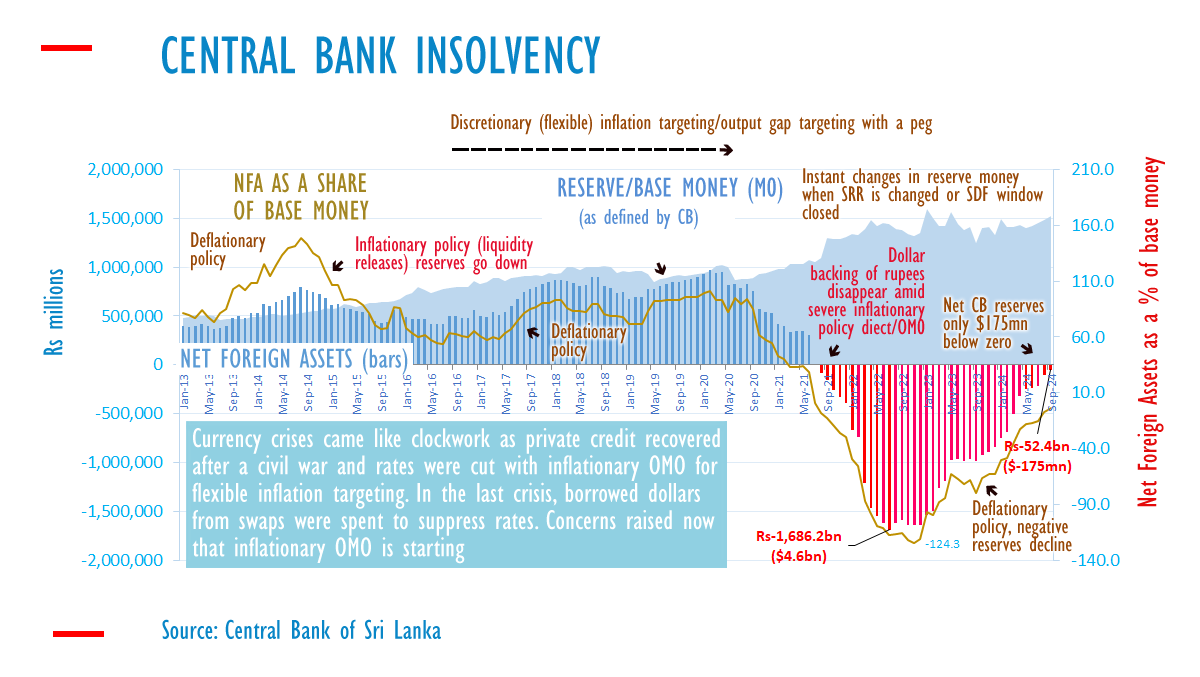
ECONOMYNEXT – Net foreign assets of the Sri Lanka’s central bank have been brought to almost zero by September 2024, through consistent deflationary open market operations after rates were hiked in April 2022.
By September 2024, the net foreign assets of the central bank were negative by only 175 million dollars from a peak of negative 4.6 billion US dollars at the height of the last currency crisis in August 2024, which ended in external sovereign default.
The central bank’s foreign reserves were a negative 4.0 billion dollars in March 2022 when the central bank hiked rates to contain domestic credit.
But due to reserves loaned by India through the Asian Clearing Union mechanism, the central bank continued to sell down reserves and re-finance domestic credit through inflationary open market or standing liquidity facilities extending the balance of payments deficits.
By July 2022, the central bank’s net reserves were negative by 4.6 billion US dollars due to combination of using central bank swaps, legacy IMF loans and Indian loans to central bank through the ACU mechanism.
Fortunately, the swap from the Peoples Bank of China could not be used to suppress interest rates due to restrictions on its use.
Deflationary Primary and Open Market Operations
From around September 2022, effects of deflationary policy were seen in the balance of payments (as reported) reported becoming positive due to the impact of deflationary open market operations.
Since August 2022 the central bank has collected reserves or repaid debt of around 4.3 billion US dollars to bring the negative reserve position to only 175 million US dollars by June.
The central bank has repaid swaps taken from the central bank of Bangladesh and also a swap and part of the borrowings from Reserve Bank of India with the help of deflationary open market operations and deflationary primary market operations (refraining from re-subscribing to maturing bills).
Reserves have been built mostly using current inflows bought from banks, though the government has also converted some dollar loans to rupees on occasion.
In the period commercial banks have also built reserves.
Banks buy dollars from exporters and remittance holders by giving them existing rupees.
The central bank buys dollars from banks by giving newly created rupees to banks, expanding reserve money.
To maintain the foreign reserves and to prevent the new rupees (which are now with bank as rupee reserve balances) the central bank has to exchange a domestic asset to prevent the money from being loaned to customers and imports.
Such a sell down of domestic assets or the reduction of money given through open market operations involving standing or term reverse repo facilities leads to a permanent ‘sterilization’ of foreign reserves by preventing domestic credit and investments.
Concerns have been raised that the central bank has begun inflationary open market operations giving banks easy money at 8.26 percent to suppress rates and push domestic credit without deposits.
Up to now the money has ended up as excess liquidity in the central bank’s standing facility with domestic private credit just beginning to recover. (Colombo/Nov17/2024)
